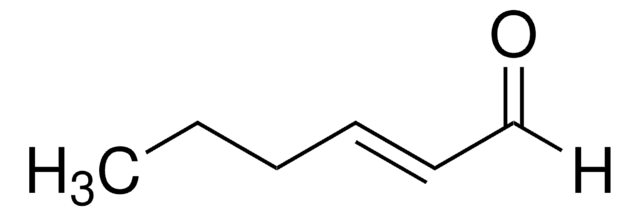W317101
cis-3-Hexenyl acetate
≥98%, stabilized, FCC, FG
Sinonimo/i:
(3Z)-3-Hexen-1-ol acetate, (3Z)-C-3-Hexenyl acetate, Leaf acetate
About This Item
Prodotti consigliati
Origine biologica
synthetic
Livello qualitativo
Grado
FG
Fragrance grade
Halal
Kosher
agenzia
follows IFRA guidelines
Conformità normativa
EU Regulation 1223/2009
EU Regulation 1334/2008 & 178/2002
FCC
Saggio
≥98%
contiene
α-tocopherol, synthetic as stabilizer
Indice di rifrazione
n20/D 1.427 (lit.)
P. ebollizione
75-76 °C/23 mmHg (lit.)
Densità
0.897 g/mL at 25 °C (lit.)
applicazioni
flavors and fragrances
Documentazione
see Safety & Documentation for available documents
Allergene alimentare
no known allergens
Allergene in fragranze
no known allergens
Organolettico
fresh; green; fruity; sweet
Stringa SMILE
[H]\C(CC)=C(/[H])CCOC(C)=O
InChI
1S/C8H14O2/c1-3-4-5-6-7-10-8(2)9/h4-5H,3,6-7H2,1-2H3/b5-4-
NPFVOOAXDOBMCE-PLNGDYQASA-N
Cerchi prodotti simili? Visita Guida al confronto tra prodotti
Categorie correlate
Descrizione generale
Applicazioni
- Volatiles from cotton aphid (Aphis gossypii) infested plants attract the natural enemy Hippodamia variegata.: This study explored how volatiles, including cis-3-Hexenyl acetate, emitted by cotton plants infested with Aphis gossypii attract the natural predator Hippodamia variegata, highlighting its potential in biological pest control strategies (Yi et al., 2023).
Azioni biochim/fisiol
Avvertenze
Warning
Indicazioni di pericolo
Consigli di prudenza
Classi di pericolo
Flam. Liq. 3
Codice della classe di stoccaggio
3 - Flammable liquids
Classe di pericolosità dell'acqua (WGK)
WGK 2
Punto d’infiammabilità (°F)
134.6 °F
Punto d’infiammabilità (°C)
57 °C
Dispositivi di protezione individuale
Eyeshields, Gloves, multi-purpose combination respirator cartridge (US)
Scegli una delle versioni più recenti:
Possiedi già questo prodotto?
I documenti relativi ai prodotti acquistati recentemente sono disponibili nell’Archivio dei documenti.
I clienti hanno visto anche
Global Trade Item Number
| SKU | GTIN |
|---|---|
| W317101-1KG | |
| W317101-200G | |
| W317101-1KG-K | 4061837527920 |
| W317101-200G-K | 4061837545986 |
| W317101-5KG | |
| W317101-5KG-K | |
| W317101-SAMPLE | |
| W317101-SAMPLE-K | 4061837527937 |
Il team dei nostri ricercatori vanta grande esperienza in tutte le aree della ricerca quali Life Science, scienza dei materiali, sintesi chimica, cromatografia, discipline analitiche, ecc..
Contatta l'Assistenza Tecnica.








